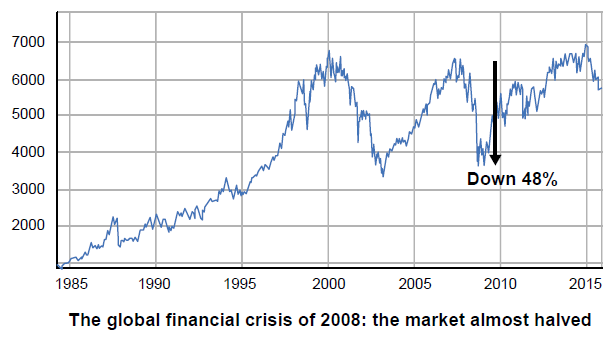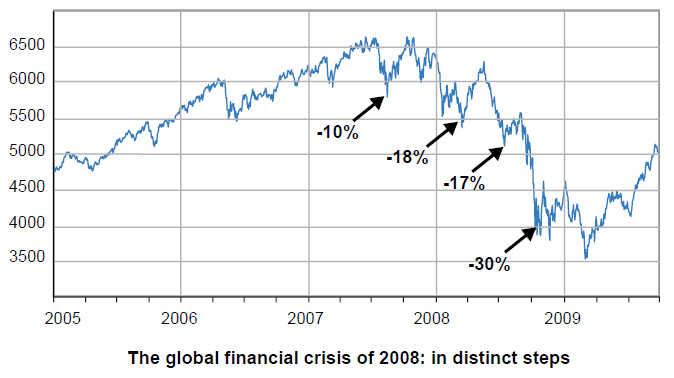Huge bear markets are scary.
Everybody panics. News bulletins are filled with dramatic stories. Share prices can drop dramatically in the space of a day. And all you’re thinking is, “I’m losing money, and I want it to stop”.
You’re torn between wanting to sell, to keep the rest of your money safe (though then your paper losses become real losses), and hanging on in the hope that the market will recover, but leaving your money at risk. It’s not nice.
Fortunately, I have two pieces of good news for you.
The first is, from the Saltydog point of view, huge 50% bear markets are not that dramatic. (I will explain this in a moment.)
And the second piece of good news is that, using the Saltydog method, you can very easily protect yourself from the worst of a huge bear market. Yes, you’ll still lose some money. You can’t be totally immune. But you won’t lose nearly as much as if you just passively sit out the collapse, waiting for the market to hit bottom and then recover again.
So… what do I mean when I say that huge bear markets are not that dramatic?
Let’s have a look at the global financial crisis of 2008.
The overall drop in the market for that period – which was actually from October
2007 to March 2009 – was 48%. Here’s the very long-term chart:

Now there’s no denying that that is a horrific picture for any investor. Losing just about half of your stock market investments in one fell swoop.
And the worst of it is that the markets dropped off a cliff. After the strong four-year bull market of 2003 – 2007 the markets reversed abruptly, and plummeted downwards. There was no flat market at the top, and so there was almost no time for any investor to prepare. The turnaround was swift and brutal. Nor was there any indication that the fall in the market would be quite so severe.
All in all, it was every investor’s nightmare.
Except that… this explanation isn’t true at all.
The first misconception we need to dispel is that huge market crashes (40% - 50%) are very sudden and occur in a very short period of time. This is just wrong.
The crash in the market due to the global financial crisis does look horrifically quick in the chart above. But that’s because it’s a very long-term chart, showing 30 years of the FTSE.
Let’s take a different perspective. Here’s a 5-year chart, where the details of the crash are clearer.
From this it’s obvious that the 48% drop wasn’t a sheer precipice, but was actually a number of distinct steps downwards to the bottom – taking place over the course of an entire year:

In July-August 2007 there was a 10% drop from the market peak.
The markets recovered briefly, regaining the previous high, and then there was a long and bumpy 18% drop over six months, all the way from October 2007 to March 2008.
There was another recovery, followed by another two-month drop of 17% from May to July of 2008.
Following another short recovery, there was a very dramatic one-month drop of 30% after Lehman Brothers collapsed in September 2008.
So what’s my point?
My point is this. The full peak-to-trough drop of 48% happened over the course of an entire year. And even the biggest drop within that year – 30% - happened over the duration of a month.
With the Saltydog system we are reviewing our data every single week, and adjusting our portfolios accordingly.
The fact is, there is no way that we would continue to invest heavily in a market that was falling like this, over such a sustained period of time. It would be against every single principle of the Saltydog system!
Now I’m certainly not claiming that you can avoid making any losses whatsoever.
That would be foolish.
The reality is that trend investing is always working “after the event”. So if a market starts falling, we can’t react to it until it’s actually started falling – which means we will lose some money initially. We can’t help that. But once we’ve moved our money out of the riskiest sectors and into safer sectors, we are definitely going to protect ourselves from any really huge losses that ensue afterwards. As the market continues to fall, the data will be telling us that things are not good - and so we’ll only be allocating our money very defensively.
Look at it this way… If the entire market goes down 50%, and you lose only 20%, that would be quite an achievement in itself. It would mean you’d saved a third of your invested wealth from disappearing. Yes, it’s still a loss – but it’s a much more manageable one. And I think that protecting yourself like this is more than achievable by anyone using the Saltydog system intelligently and diligently.
Read next > PART 3 - "How Saltydog began & other stories"

Comments
0 comments
Please sign in to leave a comment.